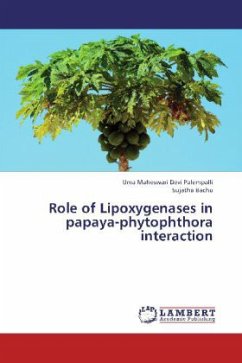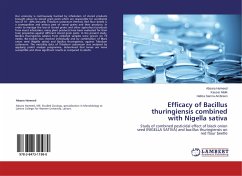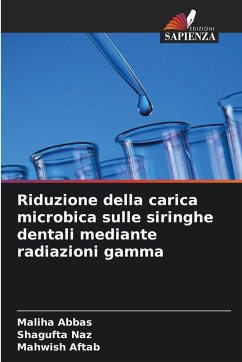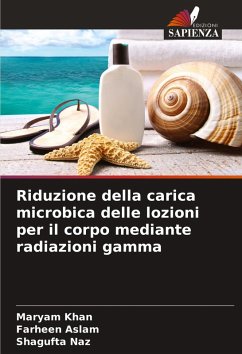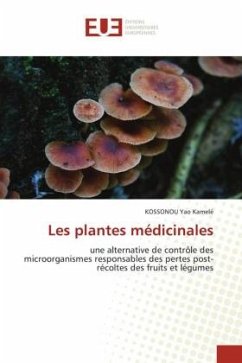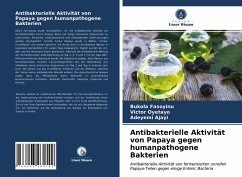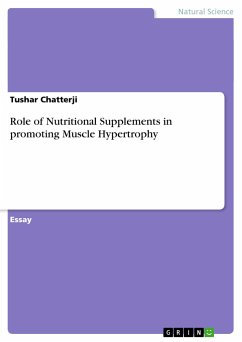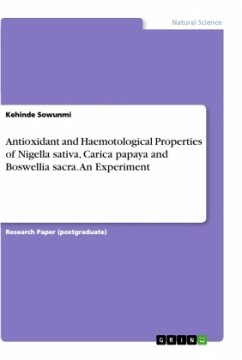
Antioxidant and Haemotological Properties of Nigella sativa, Carica papaya and Boswellia sacra. An Experiment
Versandkostenfrei!
Versandfertig in 1-2 Wochen
17,95 €
inkl. MwSt.

PAYBACK Punkte
0 °P sammeln!
Research Paper (postgraduate) from the year 2019 in the subject Biology - Cytology, grade: 5.0, University of Lagos (University of Lagos), course: Cell Biology and Genetics, language: English, abstract: This work examines the impact of the medical plants Nigella sativa, Carica papaya and Boswellia sacra with the help of an experiment conducted with fifty female albino mice.Nigella sativa, Carica papaya and Boswellia sacra are medicinal plants in the commonly used in folkloric medicine due to the presence of its immense therapeutic properties. Fifty (50) female albino mice weighing between 15-2...
Research Paper (postgraduate) from the year 2019 in the subject Biology - Cytology, grade: 5.0, University of Lagos (University of Lagos), course: Cell Biology and Genetics, language: English, abstract: This work examines the impact of the medical plants Nigella sativa, Carica papaya and Boswellia sacra with the help of an experiment conducted with fifty female albino mice.Nigella sativa, Carica papaya and Boswellia sacra are medicinal plants in the commonly used in folkloric medicine due to the presence of its immense therapeutic properties. Fifty (50) female albino mice weighing between 15-22g were divided into five groups of 10 mice each. Animal in group 1 served as control group and were administered distilled water while animal in group 2 were given 2ml of cisplatin (orally). Animal in group 3-5 were given orally; 100 mg/kg (low dose), 200 mg/kg (medium dose) and 400 mg/kg (high dose) of triherbal preparation. The feeding regimens lasted for 28 days. After 28 days, mammary gland and blood samples were collected for haematological and antioxidant analysis. The triherbal formula decreased the GSH and MDA levels of mice treated with 100 mg/kg and 400 mg/kg doses compare to control. The measurement of total protein content, SOD and CAT increased in treated animals compared to control. However, RBC (Red Blood Cell) counts significantly decreased in the low, medium and high dose groups (0.95±0.08, 6.57±0.08 and 3.55±0.55 x 106 cells/mm3 respectively) compared to control (7.34±0.40) at P<0.05. Also, significant decreases (P<0.05) in the level of the total WBC (White Blood Cell) count, platelet count, PCV (Packed Cell Volume) and Hb (haemoglobin) concentration were observed. The decreases were dose dependent. The MCH (Mean Corpuscular Haemoglobin) and MCHC (Mean Corpuscular Haemoglobin Concentration) except MCV (Mean Corpuscular Volume) significantly decreased in treated group only. The triherbal formulation exhibited significant antioxidant activities showing increased levels of SOD, CAT and Protein content due to activation of the enzyme involve in detoxification of free radicals and decreased in the level of GSH and MDA due to accumulation of peroxides and H2O2. Also, decreased in haematological parameters due to the presence of phytochemicals such as phenol, resins, saponins, sterols, tannis and terpenes in the triherbal formula. Therefore, it has potential to induce haematotoxicity hence consumption of high concentrations should be discouraged.



